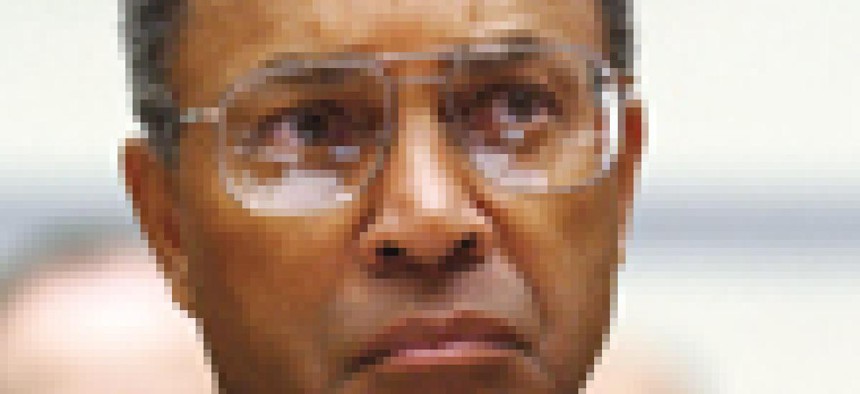Agencies warm to share in savings

Two and a half years ago, Ken Buck was glad to leave his job promoting share-in-savings contracting for the General Services Administration. He was frustrated that few agencies and contractors had tried the method, despite its authorization by law in 1996.
Two and a half years ago, Ken Buck was glad to leave his job promoting share-in-savings contracting for the General Services Administration. He was frustrated that few agencies and contractors had tried the method, despite its authorization by law in 1996. "When I left, I said 'Let it die. It just can't be done,' " said Buck, who took another position within GSA. With share-in-savings contracting, the contractor puts up some or all of the development funds and is paid from the savings or revenue that is generated.In the last year, however, Buck has had a change of heart, as have many federal agencies and their contractors. He was lured back to the share-in-savings program at GSA after reading the E-Government Act of 2002, which expanded share-in-savings contracting beyond the pilot stage and allowed agencies to keep their share of the savings. The Clinger-Cohen Act didn't allow agencies to keep their savings, providing little incentive for agencies to use share-in-savings contracting."I'm more convinced than ever that this has legs," said Buck, director of the Share-in-Savings Program Office at GSA. Federal information technology contractors and their agency customers seem more convinced as well. About 20 agencies have been working with GSA since January to identify projects that are good candidates for share-in-savings contracts, GSA Administrator Stephen Perry said. "We read that as aggressive interest" in the contracting method, Perry said. When share in savings is used for IT projects, the government gets expedited technology deployment without the full up-front expense. Its contractors, if they are successful, get a greater financial payoff than they would with a conventional fixed-price or time-and-materials contract. New procurement guidance on share in savings for contracting officers awaits approval by the Office of Management and Budget. Earlier this year, about 150 government and industry workers attended a January share-in-savings training session conducted by GSA and the Council for Excellence in Government, a nonpartisan, nonprofit think tank. Attendees learned to use new online tools developed by GSA for generating share-in-savings proposals and business cases.[IMGCAP(2)]Rob Burton, acting administrator of OMB's Office of Federal Procurement Policy, has said he supports use of the method. And Karen Evans, administrator of information and e-government at OMB, said her office will ask agencies to consider share-in-savings contracting for the next wave of e-government projects, which will entail systems consolidation along three lines of business: financial management, human resources and grants management."These initiatives have funding problems," Evans said. "The savings you get can be reinvested in IT. That's why we're thinking it would be a good model for us to look at."But share in savings isn't out of the woods yet. Some industry executives said their concerns must be addressed before many companies will bid on share-in-savings jobs.Bob Woods, president of Topside Consulting Group LLC in Vienna, Va., said agencies don't share information about their proposed share-in-savings projects with potential bidders early enough in the contracting process. "Ninety days before start is not soon enough," he said.Agencies also need to make sure their contract requirements are not too specific, said Fred Thompson, who handles e-government, GSA and Executive Office of the President programs for Unisys Corp. of Blue Bell, Pa."The most attractive opportunities are where the government has not specified requirements that control the design. When that happens, costs begin to get fixed, and there's no opportunity to achieve better savings," Thompson said. "Opportunities that have 40 pages of specs immediately become less attractive to us." One of the biggest difficulties is establishing a baseline cost against which savings are measured, said Renny DiPentima, president and chief operating officer at SRA International Inc. in Fairfax, Va. For example, if a contractor takes over an agency operation and $10 million is saved, but a policy change alters the agency operation, the agency could say some of the savings derived from the policy change and not the contractor's work, DiPentima said. "Do you still give the vendor the savings because you agreed to, or do you re-baseline everything? That issue has to be resolved before vendors are going to seriously consider share in savings," he said.Both SRA and Unisys will bid on share-in-savings projects, company officials said. But they said it's in the government's interest to solve these problems. "In return, the government would get a larger number of companies bidding," said Mary Dale, client relationship executive for GSA accounts at Unisys. [IMGCAP(3)]GSA's Perry said some of the projects under consideration for share-in-savings contracting include OPM's e-payroll project, the Army's financial systems consolidation initiative and GSA's Federal Asset Sales e-government project. James Clausen, a project manager in the Defense Department's Office of the Chief Information Officer, said program managers are being encouraged to try share in savings. Potential initiatives include replacing cash registers at the department's 275 commissaries worldwide. The original plan called for contractors to get a return on investment within three years after the technology was implemented; but Clausen said the department is trying to speed up the return. "Doing so will make the project more attractive to industry," Buck said. "I said a three-year return was too long. Now they could see some return on investment within six months." Another potential project is the Navy-Marine Corps Intranet product evaluation center. The contractor would fund operations of the center up front and get paid from the savings. The center evaluates software to ensure it meets security and operational requirements, Clausen said. The Environmental Protection Agency has several good prospects for share-in-savings initiatives, said Judy Davis, EPA director of acquisition management. EPA will soon award a task order for telecommunications audit support, in which the vendor will identify errors in phone bills and be paid from the money recovered, she said.The agency, in conjunction with the Transportation Department, is also considering funding development of an electronic manifest for hazardous waste tracking through share in savings, Davis said. Industry generates these manifests on paper, so there is no baseline cost to the government against which to measure savings. But that doesn't mean share in savings can't be used, Buck said. Automating the manifests will save money for companies that generate and transport hazardous waste, and some of that savings could be paid in a user fee to EPA, which would use the money to pay a contractor to build and maintain the system, Buck said. Federal and industry program managers regularly ask Buck to evaluate these kinds of share-in-savings proposals. That's quite a change, he said. "My phone is ringing now," he said. "Two years ago, some people were saying it was illegal."Staff Writer Gail Repsher Emery can be reached at gemery@postnewsweektech.com.




The E-Government Act put new life into the share-in-savings program, and brought Ken Buck back to promoting it for GSA.
Henrik G. de Gyor

"The savings you get can be reinvested in IT. That's why we're thinking it would be a good model for us to look at." ? Karen Evans, Office of Management and Budget
Henrik G. de Gyor

Stephen Perry